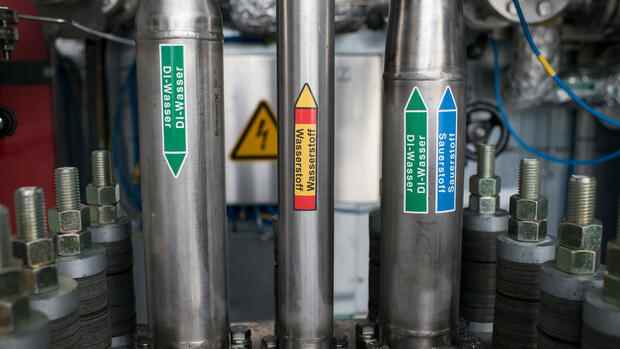Dusseldorf The energy companies Eon and Uniper want to promote decarbonization by purchasing green ammonia from Canada. Eon and Uniper announced that the companies signed letters of intent with the Canadian development company EverWind Fuels on Tuesday. Ammonia consists of hydrogen and nitrogen.
The German suppliers aimed to purchase around 500,000 tons of ammonia each year from EverWind’s Point Tupper production facility in Nova Scotia. The plant is scheduled to start commercial operation in 2025.
Germany sees hydrogen as an important long-term substitute for Russian natural gas and a way to meet its goal of meeting all electricity needs from renewable sources by 2035.
EverWind is currently planning a multi-stage green hydrogen and ammonia production and export facility, which is in an advanced stage of development and is expected to start operations in early 2025, it said. It would be the first ammonia terminal on Canada’s east coast suitable for export to Germany.
Hydrogen can only be shipped under extreme conditions
Hydrogen can only be shipped in its pure form at great expense. That’s because the molecules have to be cooled to minus 253 degrees to reach a liquid state.
Despite extremely tight containers, hydrogen is inevitably lost because the temperature cannot be reliably and constantly kept close to absolute zero, so that individual molecules revert to the gaseous state.
Therefore, transport in the form of ammonia is used. Ammonia consists of nitrogen and hydrogen and is one of the most produced basic chemicals. A large part of the world’s production is processed into nitrogen fertilizers, which are used in agriculture.
>> Read also: Green hydrogen is cheaper than hydrogen from natural gas for the first time
The production is very energy-intensive, the required hydrogen is usually obtained with natural gas or other fossil fuels. In the case of green ammonia, the hydrogen is to be produced using energy from renewable sources.
Because ammonia only has to be cooled to minus 33 degrees for transport and has a much higher energy density than liquid hydrogen, transport is easier and, above all, cheaper. The only problem is that if the ammonia is not processed directly, but instead split back into hydrogen and nitrogen, a lot of energy is needed again.
The green hydrogen should also be produced with electricity from offshore wind turbines.
(Photo: dpa)
Construction of the ammonia plant is expected to begin in 2023, EverWind spokesman Ken Summers told Handelsblatt. The plant will produce green hydrogen and convert it into green ammonia using a mix of certified green electricity from Nova Scotia’s electricity grid and onshore wind energy. Other phases of the plant will be powered by offshore wind power, enabling the production of more than ten million tons of green ammonia per year.
>> Read also: Disrupt Podcast: Can Green Hydrogen Replace Europe’s Natural Gas?
In a statement, Klaus-Dieter Maubach, CEO of Uniper, said that one of Uniper’s main goals is to effectively decarbonize other industries as well as its own. In addition, security of supply can be guaranteed with the new contract.
The EverWind project is a “very promising opportunity to source green ammonia based on excellent conditions and government relationships that support the project,” Maubach said.
Eon promises a “transatlantic hydrogen bridge”
Patrick Lammers, Eon’s COO and Chief Sales Officer, describes the deal as a transatlantic hydrogen bridge. “In this way we can bring the energy of the Canadian wind to Germany by ship.”
Signing the contract required large investments beforehand. EverWind CEO Trent Vichie has acquired a former oil storage facility at Point Tupper Heavy Industrial Park in Nova Scotia, Canada, and has invested more than $100 million of its own funds to date, including to purchase an oil terminal.
In order to start up the system, another billion dollars are planned. This also includes converting the oil loading terminal for loading ammonia tankers.
Chancellor Scholz praises the industry’s efforts
The contracts were signed during the visit of Federal Chancellor Olaf Scholz and Economics Minister Robert Habeck to Canada. “The transformation is progressing. Our industry is investing in future climate-neutral production,” said Scholz.
The agreements are not only an important step for strengthening economic relations, but also for a future-proof, sustainable energy supply.
With agency material.
More: PowerCo: VW wants to invest in raw material mines in Canada
